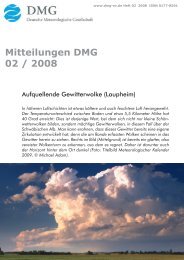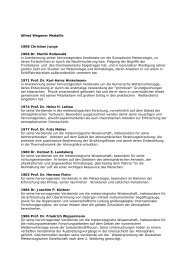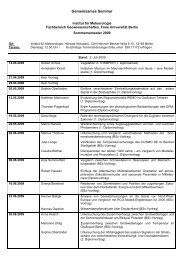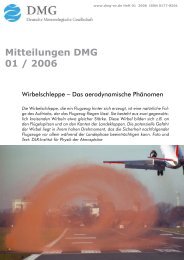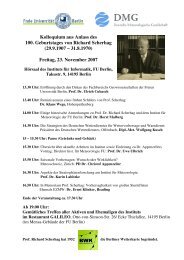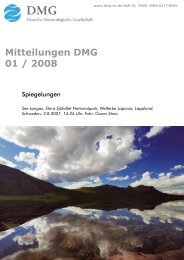Proceedings zur 6. Fachtagung BIOMET - Deutsche ...
Proceedings zur 6. Fachtagung BIOMET - Deutsche ...
Proceedings zur 6. Fachtagung BIOMET - Deutsche ...
Sie wollen auch ein ePaper? Erhöhen Sie die Reichweite Ihrer Titel.
YUMPU macht aus Druck-PDFs automatisch weboptimierte ePaper, die Google liebt.
The Influence of Climate Change and Land-use on the<br />
Water Budget of a Forested Catchment<br />
Christian Bernhofer, Uwe Eichelmann, Johannes Franke, Valeri Goldberg,<br />
Thomas Grünwald, Janet Häntzschel, Barbara Köstner, Heiko Prasse, Ronald Queck,<br />
Andreas Schreiber, Jörg Seegert und Uwe Spank<br />
Institute of Hydrology and Meteorology, Technische Universität Dresden<br />
Abstract<br />
Almost 40 yrs of water budget measurements of a forested watershed in Central Europe are<br />
utilised to investigate (i) effects of observed climate trends since the 1960ies, and (ii) effects<br />
of land-use changes due to a change in forest management since the 1990ies. Main focus is on<br />
evapotranspiration (ET) as it is expected to show the most pronounced response. Potential ET<br />
did increase due to changes in saturation deficit and radiation, though no changes are detectable<br />
in actual ET until mid of the 1990ies. Since then a clear trend of observed watershed ET<br />
exists. This can be attributed to a reduced amount of clear cuts and an increased proportion of<br />
under storey beech or a change in the reference meteorological or hydrological data used to<br />
construct watershed ET. Modelling with the lumped parameter model BROOK90 showed no<br />
change in modelled ET in the same period indicating that either parameters have to be adjusted<br />
or data need additional homogenisation.<br />
1 Introduction<br />
The interannual variation and trends in forest water budgets reflect both, land use change and<br />
change in climate. Today, with an already observed climate trend in Central Europe (e.g., of<br />
about 1K in the last 50 yrs in Germany; FRANKE et al., 2004) we investigate whether the climate<br />
signal in the observed long-term water budget can be separated from the “noise” originating<br />
from interannual variability and land-use change. Basis are flux measurements in a<br />
forested area near Tharandt (Tharandter Wald), about 25 km SW of Dresden/Saxony (GOLD-<br />
BERG & BERNHOFER, 2006). This forest has a size of approximately 60 km², and a long history<br />
of forestry documentation (about 180 yrs.) as well as meteorological and hydrological<br />
measurements: (i) climate data since mid of the 19th century, (ii) continuous hydrological<br />
data of the Wernersbach catchment since 1968 (covering 4.6 km²), and (iii) continuous flux<br />
measurements by Eddy Covariance (EC) within EUROFLUX, Carbo-Euroflux, and Carbo-<br />
Europe since 1996 (representative for approximately 0.5 km²).<br />
2 Material and Methods<br />
Altitude of the Wernersbach catchment ranges from 323 to 424 m a.s.l., slopes are moderate<br />
(40 percent of slopes






